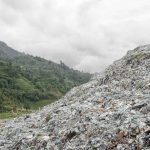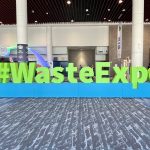Recipe for Sustainable Alphabet Soup: Terms to Digest in Waste & Recycling
– May 19, 2022 –
As sustainability professionals, we have a habit of using waste/recycling terms and acronyms. To shed some light on some of the many significant (but perhaps least obvious) terms used in describing the functions and aspects of waste and recycling, below is an industry dictionary (categorized by waste types and systems).
Ready to eat some sustainable alphabet soup?
Note: The following glossary is for educational and informational purposes, not legal.
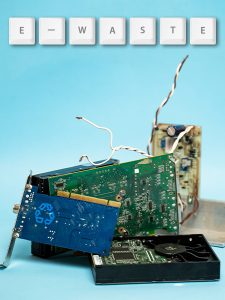
Types of Waste
Not all waste is for the landfill. They are made of many different materials, from paper and plastic to glass and metal. Each of these categories can be broken down. Let’s dive into some different waste types.
- Construction and Demolition (C&D) Waste – Materials resulting from the construction and demolition of buildings and other structures, including lumber, drywall, metals, concrete, and packaging material.
- Electronic Waste (or E-Waste) – Disregarded electronic equipment, including televisions, computers, cellphones, tablets, and other personal electronic devices.
- Pre-Consumer Waste – A material that’s reused/recycled before it ever goes to market. (Ex: Recovering paper scraps from printers during the manufacturing process.)
- Post-Consumer Waste – Any product which has served its intended use by a business or consumer. It can be sold, given away, or discarded as waste.
- Green Waste – Any solid waste comprising tree cuttings, grass clippings, and other organic debris from lawn care and gardening.
- Hazardous Waste – Waste material that poses a threat to human health or the environment. Anything with properties that are toxic, ignitable, reactive, or corrosive.
- Organic Waste – Waste containing carbon compounds that are capable of being broken down by microorganisms, including paper, food, wood, and yard debris, but excluding metals, glass, and plastic.
- Landfill Waste – The disposal of solid waste at permitted facilities in a series of compacted layers on land with daily covering of the waste with soil. Areas are carefully prepared to prevent risk to public health and are intended to be permanent.
Waste Collection and Process
When you discard something, where exactly does it all go? Every piece of waste material has a different journey and destination, and some have some significant benefits for businesses and the environment.
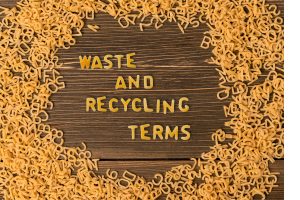
- Anaerobic Digestion – A method of composting that doesn’t require oxygen.
- Baler – A machine that binds a compacted cube or block of recyclable material.
- Commingle – A single space that houses a blended collection of recyclables from various categories (paper, plastic, metal, glass, etc.)
- Compactor – A piece of equipment that compresses materials into a denser mass.
- Composting – The conversion of organic waste into a soil-like product by microorganisms.
- Digester – A container in which substances are heated or cooked to soften or extract soluble elements from them, creating a biogas that can be used for electricity, heat, compressed natural gas and fuel. They can also create other materials, like fertilizers, compost, and animal bedding.
- Materials Recovery Facility (MRF) – A facility that sorts and processes collected recyclables.
- Municipal Solid Waste (MSW) – The combined residential and commercial solid waste generated in an area. Agricultural waste, industrial waste and sewage sludge are not MSW.
- Waste-to-Energy (WTE) – A process that recovers waste and converts it into a usable form of energy (typically electricity and heat).
Recycling & Diversion
There is plenty of waste terminology centered around recycling and diverting from landfills. Here are some you might hear the most:
- Carbon Footprint – A measure of the impact our activities have on the environment.
- Circular Economy – An economic system designed with the intention that maximum use is extracted from resources and little to no waste is generated for disposal. It helps to keep products and materials circulating at their highest value to regenerate nature.
- Closed-Loop Recycling – When materials are continually recycled into the same product, like aluminum cans and glass bottles.
- Cradle-to-Grave – A system that manages waste from creation to disposal.
- Environmental, Social and Governance (ESG) – A strategy that relies on independent ratings that help assess a company’s behavior and policies when it comes to environmental performance, social impact and governance issues.
- Life Cycle – All stages of an item’s development, from extraction to production, marketing, use and disposal.
- Leaching – Process where soluble constituents are dissolved and filtered through the soil by a percolating fluid.
- Sustainability – Meeting the needs of the current generation without compromising the ability of future generations to meet theirs. (Compared to “circular economy,” which focuses on resource cycles, “sustainability” is more broadly related to benefiting the environment, economy, and society at large.)
- Zero Waste – Efforts to emulate sustainable natural cycles, where all discarded materials are resources for others to use. It minimizes excess consumption and maximizes the recovery of wastes through reuse, recycling, and composting.
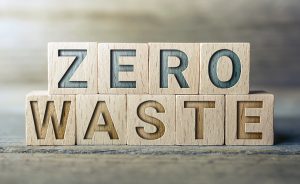
Resource: https://sor.epa.gov/sor_internet/registry/termreg/searchandretrieve/termsandacronyms/search.do





